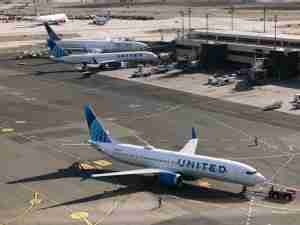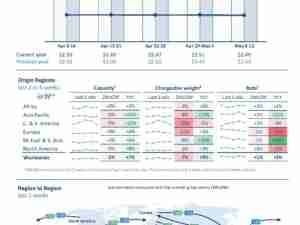After cruising along at altitude on March 21, China Eastern Airlines Corp. flight MU5735 started nosediving in a matter of seconds, an unusual delineation that will be the focus of investigators trying to understand what brought down the Boeing Co. jet.
While most plane crashes occur during take off and landing, violent descent incidents such as Monday’s crash account for an outsize portion of aviation deaths because they almost inevitably kill everyone aboard.
The China Eastern plane took just 1 minute and 35 seconds to disappear from tracking sites after it began a rapid and abrupt plunge from 29,000 feet.
It’s too early to say what may have happened, said Hassan Shahidi, the president and chief executive officer of the non-profit Flight Safety Foundation, based in Alexandria, Virginia. “In the coming days, China Eastern, the Chinese aviation regulator, Chinese investigators, and Boeing will have a lot more information as the flight data recorder, cockpit voice recorder, air traffic data and other data becomes available.”
The 737-800 is part of Boeing’s Next Generation 737s, which have a solid safety record among aircraft types, with just 11 fatal accidents out of more than 7,000 planes delivered since 1997.
While the cause of Monday’s incident is still unknown, similar incidents may provide clues.

Here’s what we know about other planes that crashed mid-flight:
Sriwijaya Flight 182, Jan. 9, 2021
A 26-year-old Boeing Co. 737-500 jet operated by the Indonesian airline took off from Jakarta with 62 people and at first flew what appeared to be a routine trajectory. After reaching about 10,000 feet (3,050 meters), it leveled off, staying between 10,000 and 11,000 feet for about 45 seconds.
At around that time, an air-traffic controller radioed the plane to say it was off course. There was no response. At roughly the same time, the plane turned left by about 40 degrees in the opposite direction from which it had been directed. At that point, the jetliner began an abrupt descent before plunging into the Java Sea, killing all on board.
While the final investigation report is still pending, a preliminary probe found that the left engine on the jet began reducing power even as the right engine setting remained the same. Unequal thrust settings can cause a plane to turn if they aren’t countered properly, and there were indications the pilots weren’t able to maintain their assigned heading, and may have been distracted by attempts to turn to avoid a storm.
Atlas Air Flight 3591, Feb. 23, 2019
As the Boeing 767-300 freighter approached Houston carrying packages for Amazon.com Inc., a copilot accidentally added engine power. Apparently disoriented and thinking the plane’s nose was dangerously high, he then pushed the plane into a steep dive, according to the NTSB.
The jet reached speeds of 500 miles (805 kilometers) per hour in seconds, smashing into a marsh in Trinity Bay and killing the three people aboard.
However, the Atlas jet was much lower than the China Eastern flight when it nosed over, and the plunge was shorter.
A Flydubai crash in Rostov-on-Don, Russia, on March 19, 2016, was the result of similar pilot disorientation as the Atlas Air flight, prompting the 737-800 to plummet from an altitude of about 4,000 feet, according to Russia’s Air Accident Investigation Commission. All 62 people on board died.
Hitting the wrong button in the cockpit can cause similar disorientation and unintended dives.
In September 2011, a Boeing 737-700 operated by Air Nippon Co., the predecessor to All Nippon Airways Co., nosedived by around 6,000 feet from a 41,000 feet cruising altitude after one of the pilots was suspected to have unintentionally operated the rudder trim control while trying to switch a cockpit door lock control to let the captain re-enter the flight deck. The incident didn’t result in a crash or any damage to the aircraft.
Silk Air Flight 185, Dec. 19, 1997
This 737-300 carrying 104 people mysteriously dove into a river in the vicinity of Palembang, Indonesia, from 35,000 feet after both crash-proof recorders were disabled.
The U.S. National Transportation Safety Board, or NTSB, which had been assisting Indonesia’s National Transportation Safety Committee in probing the crash, concluded that the captain had intentionally downed the plane. Indonesian investigators said there wasn’t enough evidence to identify what happened.
The plane was diving so fast—close to the speed of sound—that it began breaking apart, according to investigators.
USAir Flight 427, Sept. 8, 1994
This was the second of two accidents attributed to a flaw in the 737’s rudder. All 132 people on board died in the crash near Pittsburgh.
As the plane, a 737-300, approached for landing at an altitude of about 6,000 feet, its rudder jammed to one side, the NTSB concluded. The plane rolled sharply to the left and its nose pointed down toward the ground.
Several years after the accident, the U.S. Federal Aviation Administration, or FAA, mandated a rudder fix for all 737s. There hasn’t been an accident blamed on the system since.
Air France Flight 447, June 1, 2009
An Airbus SE A330 flying 228 people from Brazil to France plunged into the Atlantic Ocean from a cruising altitude above 30,000 feet.
The instruments used to determine airspeed malfunctioned after ice formed on them and the pilots became disoriented, climbing and allowing the plane to slow dangerously and enter an aerodynamic stall, French investigators found. All aboard died. The flight data recorders were discovered at the bottom of the ocean after a lengthy search.
The Air France A330 jet was rocking side to side instead of diving and dropped at an average of about 11,000 feet per minute, according to the investigation.
Malaysia Airlines Flight 370, March 8, 2014
Arguably one of the greatest mysteries in civil aviation, the Boeing 777-200 carrying 239 people disappeared en route from Kuala Lumpur to Beijing, about 40 minutes into the flight. After three years, a search for the aircraft was abandoned, and some pieces of wreckage eventually washed up on shores thousands of miles away.
While the cause of the disappearance has not been determined to this date, the Australian Transport Safety Bureau said in a November 2016 report that data and debris suggest the aircraft plunged toward the sea with no one in control after it made its last satellite communication.









